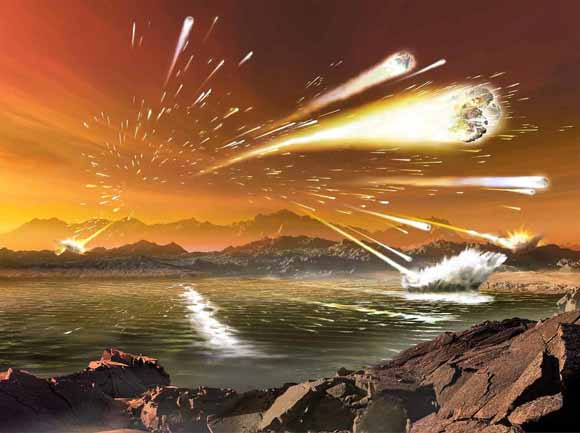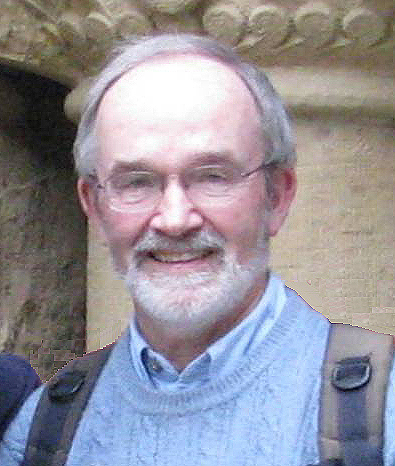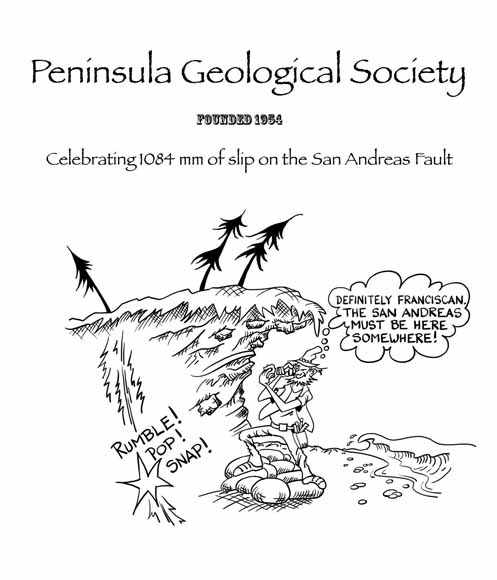
Presents
Location: Stanford University
This will be the 457th meeting since 1954
Don and Gary recently published a paper in Geology titled "Geologic record of partial ocean evaporation triggered by giant asteroid impacts, 3.29–3.23 billion years ago" doi:10.1130/G36665.1

Dana Berry/National Geographic Creative
Until recently, based mainly on lunar cratering studies, is has been thought that large-body impact rates on Earth declined rapidly after the Late Heavy Bombardment, which was thought to have ended at about 3.8 Ga. By 3.5 Ga the impact rates of large asteroids on the Earth were interpreted to have been about the same as the low levels that prevail today. Our work in the 3.55-3.2 Ga Barberton greenstone belt (BGB), South Africa, has resulted in the discovery of at least 7 and possibly 8 major layers of spherical particles ranging from 3.472 to 3.225 Ga, each representing the product of a giant asteroid impact. These impacts generated global layers of essentially pure spherules that, where undisturbed by later currents, reach as much as 35 cm thick. These spherical particles formed by the condensation of rock vapour clouds generated by large impacts. All of the layers discovered to date in the BGB were deposited in distal settings, far from the impact sites. Most have also been reworked by penecontemporaneous waves and currents thought to represent giant tsunamis also generated by the impacts. The presence of extra-terrestrial chromium (Cr) isotopic ratios in three of these impact layers confirms their origins through impacts. Estimates of bolide size based on bed thicknesses, spherule diameters, iridium and Cr fluxes suggest impactors 20-100 km in diameter. One layer has been identified in both South Africa and Western Australia. These impact layers, formed over a period of about 250 myr, are thicker than any known distal impact deposit formed at any time during the last 2 billion years of Earth history. They suggest that Earth continued to be bombarded by large extraterrestrial objects late into the Archean, at least until 3.2 Ga, well past the putative end of Late Heavy Bombardment. The 3.8-3.2 Ga development of the Earth's surface environment and life may have been constrained largely by the continuing flux of large impactors. Only as that flux declined in the Late Archean, after 3.0 Ga, were stable surface systems established within which non-thermophilic organisms and a stable geodynamic system could evolve.

Don Lowe
Don Lowe was born and raised in Sacramento, California, and attended Stanford University for his undergraduate study. In his sophomore year, he chanced to take a class in physical geology from Ben Page, which set the course of his future professional career. He decided to go back "east" for his graduate study and enrolled in geology at the University of Illinois, where he received a PhD degree in 1967. He subsequently was awarded a post-doctoral associate position at the US Geological Survey (1968-70) and started his first academic position as an Assistant Professor at Louisiana State University in 1970. He returned to Stanford in 1988 as a Professor and has continued his education, teaching, and research there since then. His research falls into two broad areas: deep-water sedimentation and Archean sedimentary systems. In the former, he examines the processes of sediment transport and deposition in the deep-sea, resulting lithofacies and lithofacies associations, stacking and facies pattern as reflecting environments of deposition, and overall basin history. The Archean research focuses on rocks older than 3.0 billion-years-old and aims to use sedimentary principles to investigate early surface environments, the nature and role of early organisms, the role of giant meteorite impacts in early crustal development, and Archean basinal settings and tectonics.
Reservations: The preferred way to make reservations is simply to email Mike Diggles at mike@diggles.com by Jan. 10, tell him you will attend, commit to pay, and bring your payment to the meeting. Mike always emails a confirmation; if you don’t get one, assume email crashed yet again and email him a second time. A check made to “PGS” is preferred, payable at the meeting.
If you want to pay in advance:
Everyone (including Stanford folks now) Please make dinner reservations by Jan. 10. Contact Mike Diggles, at (650) 329-5404. Send check made out to “PGS” to Mike.
Dinner and the social hour is $35.00; this includes $1 that we use to help pay for students who are only $8.00 (also partially subsidized thanks to the School of Earth Sciences, Stanford University (Note, no-show reservations owe the full price).
Doris, whose wonderful crew prepares our meals, asked that we let you know that people who are late RSVPing and people who show up without a reservation will be welcome but that they may be eating on paper plates with plastic utensils (food supply permitting).
Dues for Academic Year 2015–2016 ($10.00) should be sent to Mike Diggles, 345 Middlefield Road, MS-910, Menlo Park, CA 94025. Mike’s phone: (650) 329-5404.
Officers: Kevin Gill, President; Sarah Nagorsen, Vice President; Mike Diggles, Secretary-Treasurer; Elizabeth Miller, PGS Stanford University Coordinator


PGS cartoon by Rick Blakely
Date created: January 3, 2016
Last modified: February 25, 2016
Created by: Mike Diggles, Webmaster-Secretary-Treasurer, PGS.